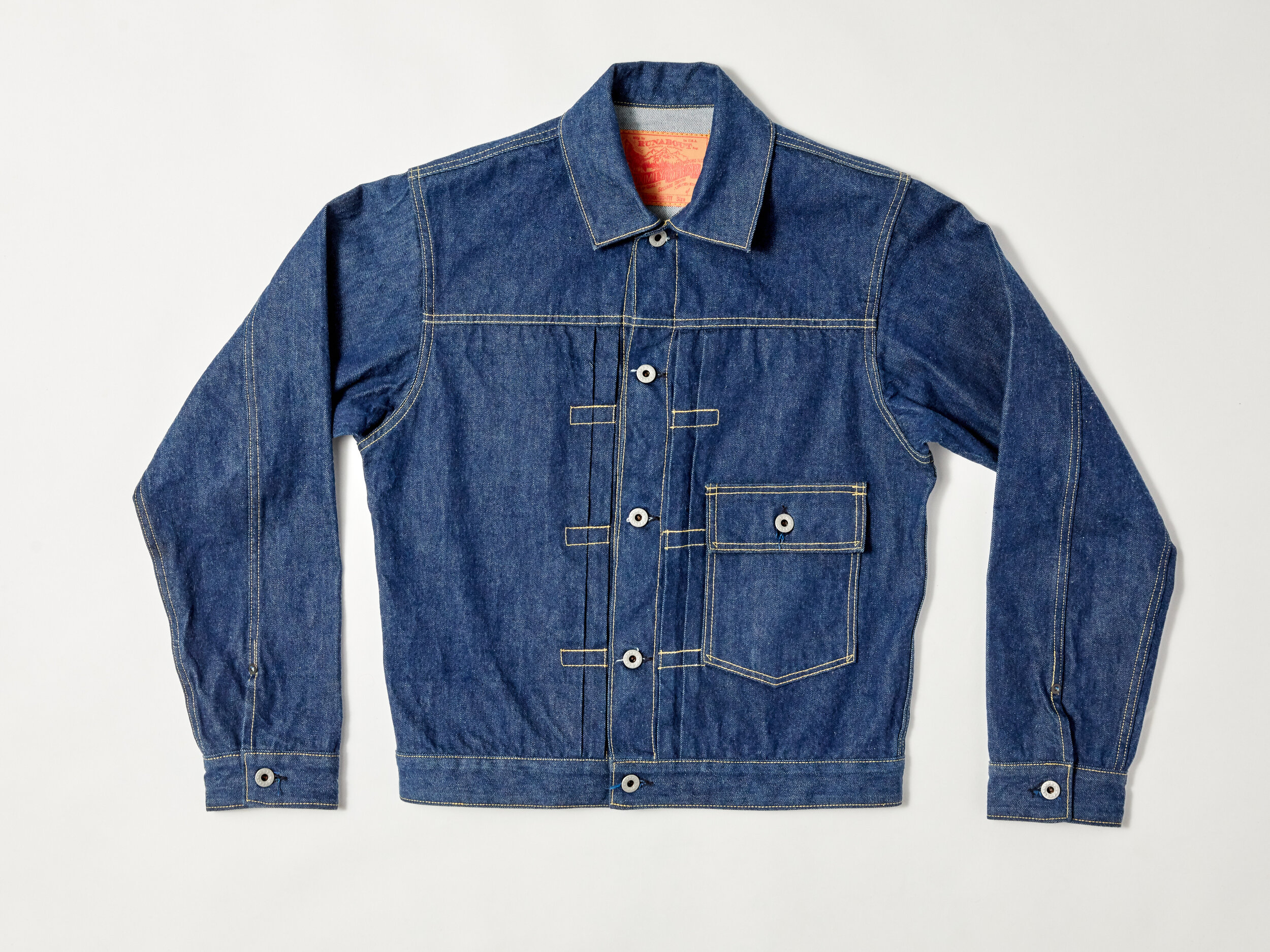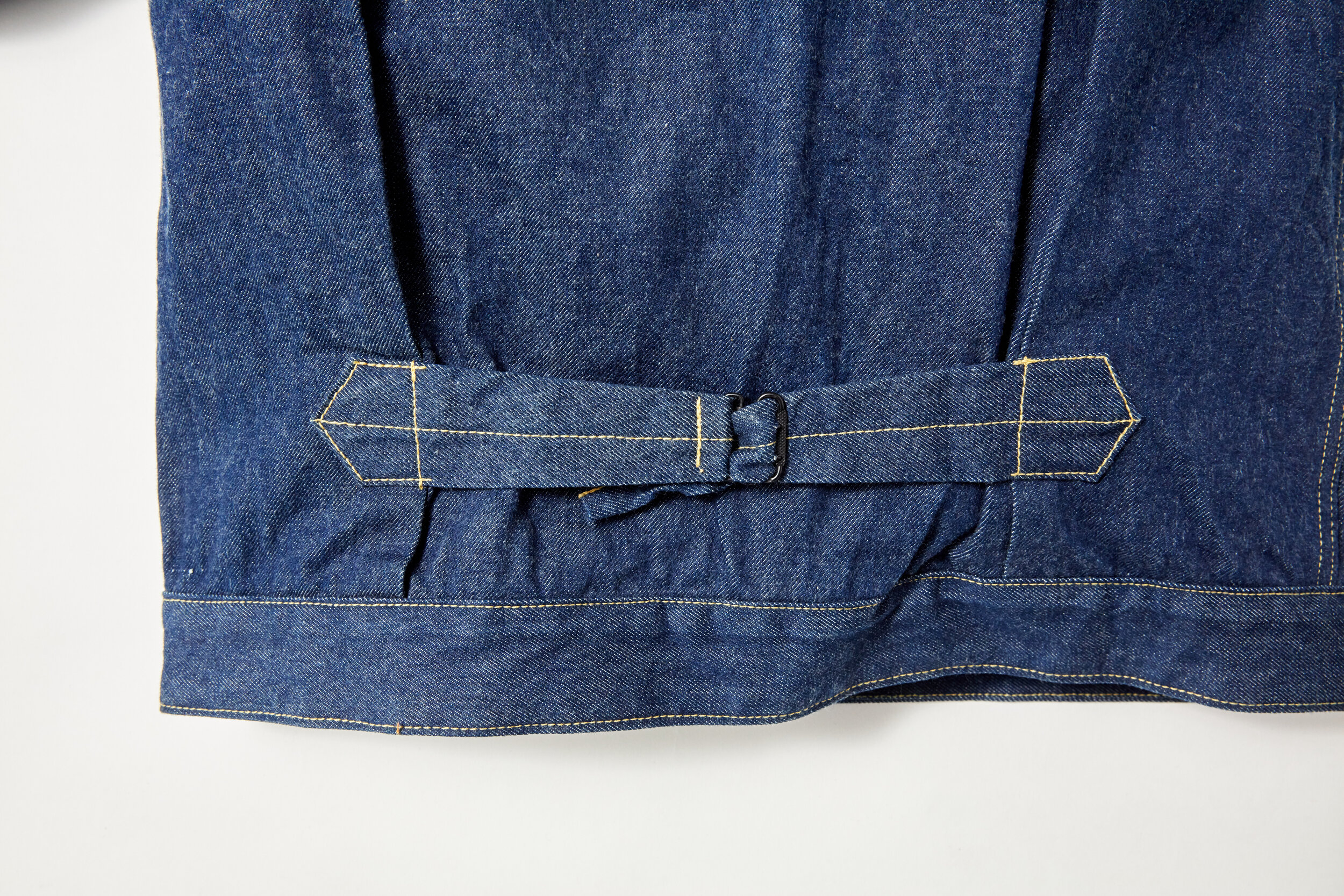The Brander
The brander type 1 jacket
Embrace the raw, unfiltered essence of "The Bikeriders," inspired by Danny Lyon's iconic 1967 photo-book, now brought to life on screen by Tom Hardy and Austin Butler. The 'BRANDER' jacket, originally styled in the 1940s but popular in the 50s and 60s, is a tribute to the rebellious spirit and rugged charm of motorcycle culture. Crafted from selvedge denim woven on antique shuttle looms, this jacket combines vintage Americana style with modern durability.
About the brander
This garment uses cloth from the inaugural production run of Proximity Manufacturing Company, a Greensboro, NC-based textile producer that weaves cloth on vintage Draper X-3 fly shuttle looms on the original hardwood floors inside the White Oak Cotton Mill, formerly occupied by Cone Denim. The cloth is constructed from 100% US-grown, ringspun cotton yarn. The 9-dip, 9% indigo warp shade known as Canyon Blue is filled with yarn with a low twist count and woven using a high pick per inch count, resulting in a densely woven denim with a steep twill line. The cloth weighs 12.2oz per square yard, and it is both unsanforized and loomstate, which is highly-coveted in the denim enthusiast community, as it develops a soft, hairy hand with wear, and also undergoes no finishing, known as sanforizing, where the cloth is mechanically shrunk to prevent any size distortion in mechanical washing and drying systems.
“Long live denim. It isn’t dead, not yet anyway”
THE W.O.L.F. PROJECT
The W.O.L.F. foundation is working to preserve the history and heritage of denim and jean manufacturing in Greensboro, North Carolina. They formed a group of board members that will run the foundation. Each of them has different tasks to achieve their mission goals, so the rich history behind the state of North Carolina’s textile industry is never forgotten.
The Goals Of W.O.L.F.
Support the preservation of historic landmarks pertinent to denim and jean manufacturing.
Collect and preserve artifacts from Proximity Manufacturing Company and similar organizations in the Greensboro area.
Preserve and operate a small number of shuttle looms to produce reproductions of selvage fabrics and garments.
Promote the proliferation of new manufacturing technologies that are more sustainable, especially new dyeing techniques (conventional dyeing was patented at White Oak in 1921).
Promote the use of sustainably grown cotton in denim and work to reduce the use of man-made polymers.
Educate the public and interested business partners through tours, displays, workshops, etc., emphasizing the reproduction of vintage denim using new sustainable technologies while still weaving on antique looms.
Insofar as possible, promote the preservation of sewn products or textile jobs in the area.
Support research efforts of others that are in line with these goals.
Promote Greensboro as a destination for those interested in the production of denim, jeans, indigo, and the history of denim production.
Encourage and support the establishment of an ‘open source’ denim and jean development center that would be open to all brands wishing to develop products.
Encourage the establishment of ‘The Denim Exchange’, a showroom for denim from around the world.
Support research on the use of natural indigo grown within the USA.
Maintain a close working relationship with the National Cotton Council, Cotton Inc., and others interested in promoting sustainable US cotton production.
Support education and research by North Carolina State University, the University of North Carolina at Greensboro, Clemson University, Texas Tech University, Gaston Textile Technology Center, and inventors as it pertains to denim and jean manufacturing.
Our Story
I met Mike in the late Summer of 2013, when I was in Los Angeles sewing on a production run of shirts to take to Denim Bruin in San Francisco. I cold called him, and asked him if we could meet. He obliged, and came to The Brewery Artist Lofts to pick me up the workshop, and took me to his shop, several favorite restaurants, and invited me to stay the night with him at his home, so that I could go with him to an early Ford hot rod meet up the next morning. The experience of someone so highly regarded in this niche of the industry, reaching out with open arms to take me in and introduce me to his store, staff, family, and friends was beyond memorable. I told him of my dreams to open a stand-alone store, and also to become involved in the weaving of denim. He used to freelance for White Oak, and designed several of their logos in the early 2000’s, and his love for denim and connection to Greensboro is deep, his understanding of our iconic history and role in the story of denim is vast.
We have remained close friends ever since our first meeting, and he has continued to serve as a mentor, cheerleader, and friend. When I called him and told him our plans to put some of the shuttle looms back online, his excitement was apparent. I remember when he used to say ‘American denim is dying.” Well, long live denim. It isn’t dead, not yet anyway. This year, we started weaving denim on the same old floors, in the same old building, with the same old looms again! It isn’t cheap, but it never was going to be. It wasn’t the easiest thing to pull off, but it was the right thing to do, for our city, for our community, and for all of those small brands that built their niche in the industry from the beautiful cloth that rolled off shuttle looms in our city from 1896 until early 2018. When I sent him a video of us weaving and the denim coming off the loom, he called and told me something I will never forget: that we saved the soul of our city. In some ways, he isn’t wrong. When the opportunity came to produce clothing with the cloth from our inaugural run, he wanted to do something special, using a historic style that is iconic in its own right. The jackets that he made out of the denim that we wove look timeless. And that good old sturdy blue cloth still being made in Greensboro should stand the test of time, too.
Evan Morrison | Director, Proximity Manufacturing Company
Care
DO NOT BUY THESE IF YOU ARE GOING TO WASH THEM LIKE YOUR OTHER CLOTHES!
American-made selvage denim is hard to come by these days. A few others are making their interpretive versions of it, but we believe that we are doing it “like they used to.” Our city, Greensboro, was built from textiles into what it is today, and we at Proximity Manufacturing Company are doing our part as the caretakers and stewards of this legacy in its third consecutive century.
EXPECT THESE JACKETS TO SHRINK 2” IN THE TORSO & SLEEVE LENGTH AND 1-2" IN THE CHEST WITH PROPER CARE AND WEAR
Denim is filled with 10/1 natural ringspun yarn, the most classic and iconic color combination of denim. The shade is reminiscent of the first yardage woven at White Oak in 1905, a lighter indigo shade, coming in at 9%, creating a unique color in cloth form.
THIS DENIM IS UNSANFORIZED, IT WILL SHRINK, WE INTENDED FOR IT TO.
In the old days, a storied brand on the west coast used to purposely build their famous cowboy jackets oversized, purposely tagging them to measure as shrink-to-fit garments. This very brand also encouraged purchasers to put their new jeans and jackets on and jump in the pool or bathtub, get sprayed down with a hose, or flip them inside out and submerge them in a sink, in lukewarm water, and then wear them while damp before hanging them to dry outdoors, to yield the perfect, formed fit to the wearer’s body. Jeans and jackets made from this type of unsanforized cloth become beloved, treasured, and ultimately take their place in your wardrobe as a go-to staple, breaking in over time and developing character in fades, creases, and wrinkles that match your body, individually. The shrink-to-fit nature allows the cloth to mold and sculpts itself in a manner that is only otherwise observed in tailored clothing.
Please note that the Washed sizes are approximate within reason, and final garment measurements may be slightly different.

















